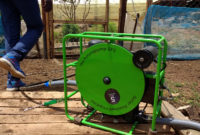Irrigation pumps are used to pump water from a lower to a higher level from which the water then flows through channels to the fields requiring irrigation (lift operation) or to raise it to the required pressure head so that it can be sprayed on the fields via piping systems (sprinkling). The heads involved range from approx. 1 m for normal lift operation to 40 m for sprinkling. In special cases, heads exceeding 100 m may be required.
The benefits or advantages of irrigation pumps are:
- Irrigation System Flexibility– Agricultural irrigation systems are typically zoned by field size, crop type and/or crop maturation date. In many cases this type of zoning can lead to zones of widely different flow rates, especially when a grower may have several small or irregularly shaped fields. In the past the solution to this problem is to size the pump for the worst possible case and then try to come up with some combination of valves to get the pump to operate at the best efficiency point. Invariably there is always a zone or two where the pump is way oversized for the application. This can cause unnecessary wear and tear on the irrigation system and cause higher energy consumption and costs. The Variable Frequency Drive (VFD) allows the pump to be run at a lower speed thus reducing the pump’s performance. The advantage of the VFD is that you can customize the way your irrigation systems runs by changing the pump’s speed of rotation. This means a smaller zone can be run and the system will slow the pump down thus reducing the flow and pressure to deliver exactly what is needed to operate the smaller zone. This can provide a huge energy savings over the course of the growing season.
- Water Conservation– Variable Frequency Drives (VFD’s) also help in conserving our planets most valuable resource. VFD’s conserve water by operating irrigation sprinklers at the optimum pressure. Over pressurized sprinklers tend to “fog” or mist as the higher pressure creates smaller water droplets through the sprinkler’s nozzle. These smaller droplets are more susceptible to movement by wind and are more easily evaporated into the atmosphere. Water that evaporates before it hits the ground is obviously of no use to the plant.
- Several Pumps In One– It used to be that irrigation pump stations consisted of a small “jockey” or pressure maintenance pump and one or more main pumps. The pump station control system turned pumps on and off depending on the flow rate required by the system at the time. The VFD essentially eliminates the need for the small jockey or PM pump. With a VFD now one of the larger pumps can serve as the jockey or PM pump to provide water to the system when the pressure and flow rate requirements are, but it can also step up and deliver higher flows and higher pressure when the system demand dictates.

The main disadvantage is that they use rotation instead of suction to move water, and therefore have almost no suction power. This means that a centrifugal pump must be put under water, or primed, before it will move water.
Centrifugal pumps can also develop a phenomenon called “cavitation”. This happens when the speed of the water causes it to vaporise, which causes bubbles in the liquid. A combination of the speed of the vapour bubbles and the implosion of vapour bubbles can be corrosive to the impeller surfaces and pump casing.
For most household or light industrial uses, a centrifugal pump is fine. As long as the liquids aren’t too viscous, like mud or waste, and the pump can be totally submerged, it will provide consistent, effective, and reliable operation. Centrifugal pumps provide a lot of flexibility, are easy to move, and don’t take up a lot of space.
